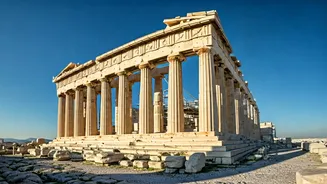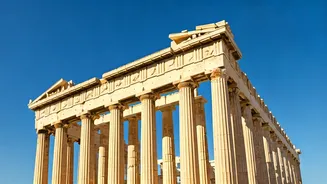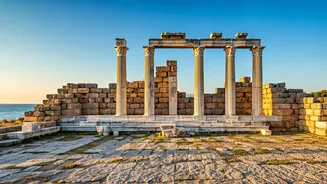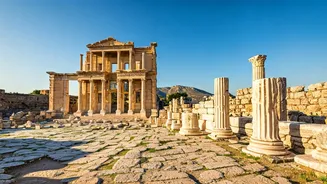Acropolis of Athens
The Acropolis, perched high above Athens, stands as an eternal symbol of classical Greece. This UNESCO World Heritage site is home to the Parthenon, a temple
dedicated to Athena, the city's patron goddess. The architectural marvels, constructed during the 5th century BC, showcase the incredible skills of ancient Greek architects and artisans. Besides the Parthenon, the Propylaea, Erechtheion, and Temple of Athena Nike further enhance the historical significance of the Acropolis. Visitors can explore these structures and marvel at the harmonious blend of artistry and engineering that shaped ancient Athenian society. The site also provides breathtaking panoramic views of the modern city, blending history with contemporary life. The Acropolis is not just a collection of old buildings; it's a testament to the cultural heights reached by the Greeks.
Delphi's Sacred Site
Located on the slopes of Mount Parnassus, Delphi was an ancient sanctuary of great importance, renowned as the home of the Oracle. People from across the ancient world came to Delphi seeking guidance and prophecies. The Temple of Apollo, the focal point of the site, once housed the oracle's seat. Visitors can explore the archaeological remains of the temple, the treasury buildings erected by various city-states, and the ancient theater. The stadium, where Pythian Games were held, is another remarkable feature. The environment enhances the spiritual aura of Delphi, with its stunning views across the valley, further amplifying the feeling of the site's rich history. Delphi is a reminder of the ancient Greeks' deep engagement with the divine and their commitment to seek answers and counsel about their future.
Ancient Olympia's Games
Olympia, in the Peloponnese, is the birthplace of the Olympic Games. This sanctuary included temples, athletic training facilities, and areas for religious ceremonies. The Temple of Zeus, the largest temple on the site, once housed a massive statue of Zeus, which was one of the Seven Wonders of the Ancient World. The ruins also contain the ancient stadium, where the Olympic competitions took place, and the Palaestra, used for training in wrestling and other sports. Exploring Olympia allows visitors to connect with the origins of sports and competition. It also highlights the significance of athletic pursuits in the ancient Greek culture. The site's ruins offer insight into ancient religious practices, the values of the games, and the way athletic achievements were held in high regard.
Knossos Palace, Crete
The Palace of Knossos, located on the island of Crete, is a crucial site for understanding the Minoan civilization. The palace's complex architecture, with its intricate layout and vibrant frescoes, mirrors the sophistication of Minoan society. It also presents unique insights into their artistry. The site reveals insights into Minoan society's lifestyle, including its governance, religious practices, and economic activities. Visitors can wander through the remains of the palace's numerous rooms, courtyards, and grand staircases. Knossos also highlights the artistic achievements of the Minoans, showcasing elaborate artwork and advanced building techniques. It is believed to have been the location of the famous Minotaur myth, adding a mysterious layer to the site's allure.
Ephesus' Ancient City
Ephesus, a well-preserved ancient city in modern-day Turkey, was once a thriving Greek city. The city boasts impressive structures like the Library of Celsus, which housed a vast collection of scrolls and was an important center of knowledge. The Temple of Artemis, one of the Seven Wonders of the Ancient World, also drew visitors from all over. The Grand Theatre, with a capacity for thousands of spectators, showcases the importance of drama and public events. The city’s ancient streets, temples, and residential areas offer insights into the daily life of ancient Ephesus. The well-preserved state of the ruins shows how the Romans and Greeks built and managed the city in the past, including public spaces, and markets.
Ancient Corinth's Legacy
Ancient Corinth, located on the isthmus connecting the Peloponnese to mainland Greece, was a significant hub in ancient times due to its strategic location. The Temple of Apollo and the agora (marketplace) are well-preserved and allow visitors to grasp the city's commercial and religious life. The Acrocorinth, a high citadel towering over the city, provides stunning views and reflects the strategic significance of Corinth. Corinth was known for its wealth, culture, and active trade, making it a critical junction for commerce and cultural exchange. The site's ruins reveal the city's significance within the ancient world, from its architecture to its influential role in trade and warfare. The ancient city’s remains reflect the complex interplay of power, trade, and culture that shaped the Greek world.
Mycenae's Citadel
Mycenae, a powerful Bronze Age city, offers a glimpse into the heroic world of Greek myths. The Lion Gate, with its iconic relief, and the Cyclopean walls showcase the advanced architectural and defensive strategies of the Mycenaean civilization. Inside the citadel, the Treasury of Atreus, an impressively built tomb, and the royal graves reveal rich insights into the lives of rulers and their practices. These features exhibit the sophistication of Mycenaean architecture and social structure. Mycenae's remains connect directly to ancient tales, including the stories of Agamemnon and the Trojan War, which has further enriched the site's allure. The ruins provide a view of the past and the lasting impact of mythical and historical significance.
Meteora's Monasteries
The Meteora monasteries, perched atop dramatic rock formations in Thessaly, are a unique blend of nature and human endeavor. These Eastern Orthodox monasteries date back to the 14th century and offer a striking contrast against the natural environment. The monasteries, accessible via winding paths, once served as centers of spiritual life, offering seclusion and inspiring reflection. The interiors of the monasteries feature stunning frescoes, religious icons, and architectural marvels, showcasing the religious faith and artistic talent of their inhabitants. Meteora is a UNESCO World Heritage site and offers a spiritual experience that highlights the importance of faith and the enduring human spirit.













